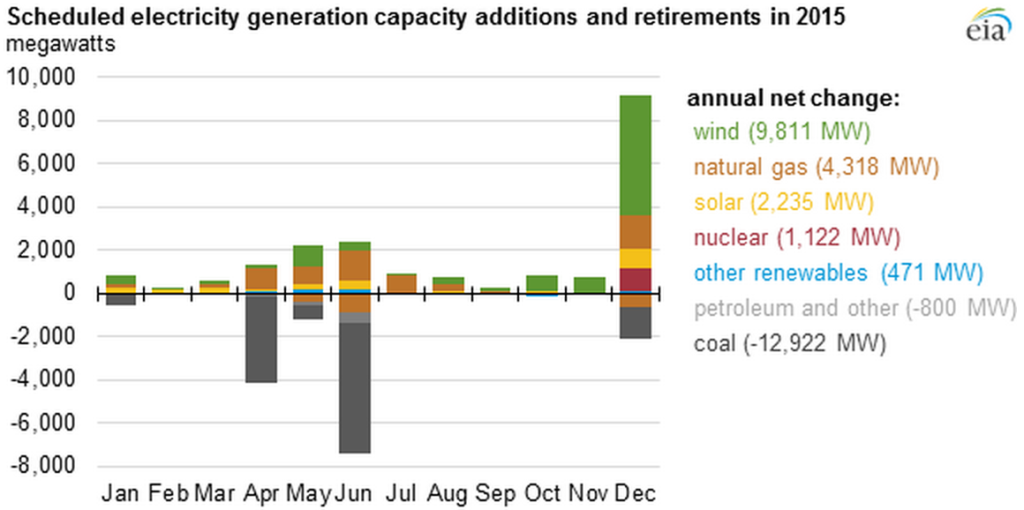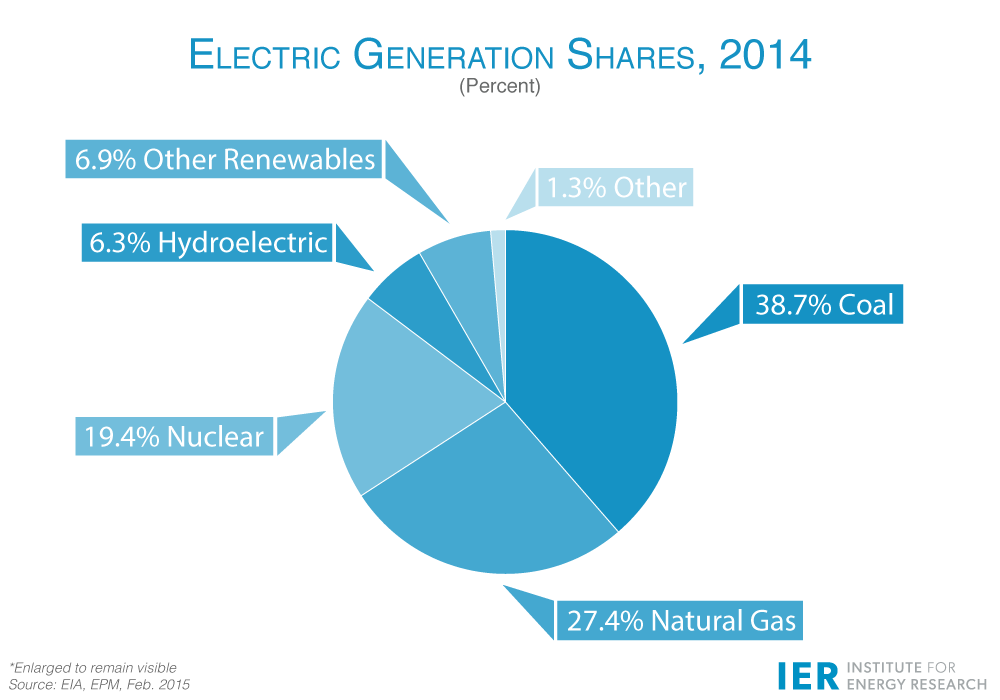From data reports provided to the Energy Information Administration (EIA), about 16 gigawatts of generating capacity will be retired in 2015, of which nearly 13 gigawatts is coal-fired. The coal-fired capacity will be retired primarily because of EPA’s Mercury and Air Toxics Standards (MATS), which requires coal- and oil-fired electric generators to meet stricter emissions standards by incorporating emissions control technologies or retire the generators. Most of the retiring coal capacity (8 gigawatts) is in the Appalachian region–Ohio, West Virginia, Kentucky, Virginia, and Indiana—where job losses have already occurred. [i]
Electric generating companies reported that they will add over 20 gigawatts of utility-scale generating capacity to the power grid, but only about 6 gigawatts of these new capacity additions are reliable (i.e. dispatchable) sources of electricity generation needed to counter balance the closure of coal and petroleum generators. Twelve gigawatts of unreliable (i.e. non-dispatchable) wind and solar will be added to the electric grid.
Because of varying capacity factors for the different generating technologies that are being added to the grid, the capacity measure is not equivalent to the amount of generation that can be expected. For example, 1 gigawatt of nuclear capacity will produce over 3 times the amount of generation that 1 gigawatt of wind capacity can produce. Furthermore, unlike wind which obviously depends on the vagaries of weather, nuclear generation is reliable.
Note that the capacity values in this graph are net changes, i.e. capacity additions minus retirements.
Source: EIA, http://www.eia.gov/todayinenergy/detail.cfm?id=20292
Generating Capacity Additions in 2015
The additions reported by electric generating companies to EIA following the trend of recent years are dominated by wind (9.8 gigawatts), natural gas (6.3 gigawatts), and solar (2.2 gigawatts). The wind capacity additions are mostly in the Plains states, with almost 8.4 gigawatts (85 percent) of total wind additions located between North Dakota and Minnesota in the north, to Texas and New Mexico in the south. Solar capacity additions larger than one megawatt are mostly located in California totaling 1.2 gigawatts. California and 28 other states have a renewable portfolio standard (RPS) requiring a specified amount of qualified renewable generation. These solar figures do not include small-scale installations such as residential rooftop solar photovoltaic systems.
Natural gas capacity additions are located throughout the United States, with Texas adding more than double any other state (1.7 gigawatts or 27 percent of total natural gas additions) in 2015. The Tennessee Valley Authority’s Watts Bar 2 nuclear facility (1.1 gigawatts) in southeastern Tennessee is expected to come on line in December 2015. It will be the first new nuclear reactor brought online in the United States in nearly 20 years.
Coal Retirements in 2015
Nearly 16 gigawatts of generating capacity is expected to retire in 2015 of which 12.9 gigawatts is coal-fired—10.2 gigawatts of bituminous coal and 2.8 gigawatts of subbituminous coal. The 85 coal-fired generators retiring this year are smaller than the average coal-fired units in the United States with an average capacity of 158 megawatts compared to 261 megawatts for the other coal-fired units. Most of this retiring coal capacity is found in the Appalachian region where coal-fired capacity has already been shuttered due to EPA regulations.
The capacity of the coal-fired units retiring this year is over 3 times the amount that retired last year because EPA’s MATS requires that they add emissions control technologies this year, although some units have been granted extensions to operate through April 2016. EIA expects an additional 5.2 gigawatts of coal retirements in 2016.[ii] If adding emissions control technologies is cost-prohibitive, operators of generating units will retire their units instead. MATS require significant reductions in emissions of mercury, acid gases, and toxic metals.[iii] It should be noted that, according to EPA, the benefits of reducing mercury and air toxics total $500,000 a year, but the rule costs $9.6 billion a year. [iv]
The 12.9 gigawatts of coal-fired capacity reported to be retired by electric utility operators in 2015 is also 3 gigawatts larger than EIA expected in July of 2012 when the agency reported 27 gigawatts of coal-fired capacity to retire between 2012 and 2016, with 9.9 gigawatts of coal-fired retirements in 2015.[v]
Despite the 21 gigawatts of coal-fired retirements between 2009 and 2014 that EIA has recorded, coal remains the number 1 generating source in the United States with a 39 percent share, followed by natural gas and nuclear. (See graph below.)
Source: EIA, http://www.eia.gov/electricity/monthly/epm_table_grapher.cfm?t=epmt_1_01
Conclusion
President Obama and his EPA are living up to the President’s proclamation in 2008, “So, if somebody wants to build a coal plant, they can – it’s just that it will bankrupt them.”[vi] But the EPA is not just dealing with new coal-fired power plants, but existing coal-fired plants as well. The MATS regulation is just the beginning with over 39 gigawatts of coal-fired plants being retired.
EPA released its proposed rule mandating carbon dioxide emission cuts for existing power plants on June 2, 2014. This rule is designed to comply with the president’s plan to make electricity rates “necessarily skyrocket” by reducing the use of coal-fired electricity generation from existing power plants—one of the cheapest sources of electricity generation. EPA is mandating the reduction of carbon dioxide emissions from the power sector by 30 percent from a “2005 baseline” by 2030. The proposed rule provides each state with a target and a set of options that EPA has determined will allow them to reach their assigned requirements. While the rule will result in increasing electricity rates, the rule will not have any material climate benefit despite the fact that the climate is the justification for the rule. EPA’s climate model calculates that the temperature reduction from the proposed rule to be a mere 0.018 degrees Centigrade by 2100.[vii]
EPA also issued a proposed rule limiting carbon emissions on new power plants. The rule limits carbon dioxide emissions from new coal plants to 1,100 pounds per megawatt-hour, although the average current coal-fired power plant emits close to 1,800 pounds. The EPA justifies these numbers by suggesting that new coal-fired plants can meet the limit by installing carbon capture and sequestration technology. However, that technology is not commercially available, meaning no new coal-fired plants will be built.[viii]
As we see from the EIA data above, coal-fired power plants are the backbone of our electric generating sector and should be encouraged to continue to provide low cost electric generation rather than be forced to retire when the electric generation sector has already done a yeoman’s job at reducing criteria pollutants and carbon dioxide emissions from its power plants.
[i] Energy Information Administration, Scheduled 2015 capacity additions mostly wind and natural gas; retirements mostly coal, March 10, 2015, http://www.eia.gov/todayinenergy/detail.cfm?id=20292
[ii] Daily Caller, EPA Rules To Force 85 Coal-Fired Generators To Close By The End of This Year, March 10, 2015, http://dailycaller.com/2015/03/10/epa-rules-to-force-85-coal-fired-generators-to-close-by-the-end-of-this-year/
[iii] EPA, http://www.epa.gov/mats/
[iv] Federal Register, February 16, 2012, http://www.gpo.gov/fdsys/pkg/FR-2012-02-16/pdf/2012-806.pdf
[v] Energy Information Administration, 27 gigawatts of coal-fired capacity to retire over the next 5 years, July 27, 2012, http://www.eia.gov/todayinenergy/detail.cfm?id=7290
[vi] Washington Times, Chance to block Obama’s war on coal, June 19, 2012, http://www.washingtontimes.com/news/2012/jun/19/chance-to-block-obamas-war-on-coal/
[vii] Cato Institute, 0.020C Temperature Rise Averted: The Vital Number Missing from the EPA’s “By the Numbers” Fact Sheet, June 11, 2014, http://www.cato.org/blog/002degc-temperature-rise-averted-vital-number-missing-epas-numbers-fact-sheet
[viii] Wall Street Journal, How to Fight the Unilateral President, February 17, 2014, http://online.wsj.com/news/articles/SB10001424052702304302704579335073537509410?mod=rss_opinion_main





